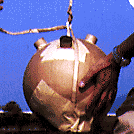Kyoku-do
From PyroGuide
The word "kyoku" is japanese in origin and means something like "a stunt display", while "do" is best translated with "trajectory". Kyoku-do means a kind of fireworks piece attached to the outside of a shell which displays effects on the shell trajectory. Such devices e.g. "tails", small flowers, whistles, comets are generally denoted with the prefix "ascending" resulting in full fireworks names such as: Amber chrysanthemum with Kyokudo of ascending small flowers. Such a shell displays small flowers on its way up and on the apex it breaks into a large amber chrysanthemum.
Ascending effects generally are very pleasing to the crowd when shot in a display. Spectators follow the bright streams of fire, breaks etc. and often do not expect the sudden apex bursts. While the use of some effects such as small flowers will be limited to large size shells, many other kyoku-do e.g. tail comets are both easily made and convenient for smaller shells.
Nevertheless there are some manufacturing guidelines for Kyoku-do:
1.) The pieces have to be made sufficiently strong to resist the initial shock from the lifting charge without breaking apart or separating from the shell.
2.) They must be ignited by the flame of the lifting charge.
_________
Some different possibilities for kyoku-do:
- Ascending tails (comet effects):
These items are quite popular and both effective and easily manufactured. They are in fact comet stars attached to the outside (top side) of an aerial shell, which will leave a bright trail of sparks behind the shell while it´s reaching the apex.
Bright compositions suitable for comets should be used for the effect (others can be tried out of course) and these are made into cylindrical comet stars of various sizes, generally depending on the shell diameter.
The compositons are wetted and best pressed with a hand or hydraulic press and mold. The water amount needs to be adjusted with the pressing loads used, higher loads will require less moisture.
I guess pumped stars made with larger diameter comet pumps can also be used if they are carefully manufactured.In either way the compositon needs to be solidly compacted with a good deal of force, otherwise the stars often do not fullfill criteria 1 and break apart.
The stars should be at least 20mm in diameter and about the same in lenght, a common size for intermediate shells being 32 or 42mm in diameter and 20mm in lenght.
After manufacture the stars are covered with thin paper on the side and dried in the shadow. Avoid direct sunlight or the stars often crack during drying. They are adequatedly primed and attached to the shell as follows: A piece of kraft paper is cut out and pasted around the star (leaving exposed the ends of the star); the paper is stripped where it doesn´t cover any star surface to allow the unit to be fastened to the shell by pasting down the resulting strips. The pasting is strengthened by applying some more layers of pasted kraft. Go sure that the pieces are properly attached.
The last step is to paste thin kraft or kozo paper around the side of the star, making it overlap the star in lenght. One or two pieces of blackmatch are bent down and brought into contact with the star prime. These are secured covering the upper star surface using the overlapping paper followed by cording up the bag-like cover with some string, making the matches protrude out of the "bag" to expose their ends. The matching may not be necessary. Alternatively the stars´ ignition surface can be dipped into some grain powder immediately after applying the primer slurry.
The following are some classic comps for ascending comets given by Shimizu. There may be a great variety of suitable comps of course.
|
| ||||||||||||||||||||
Continued!
Some examples of Kyoku-Do on 6" shells can be seen in the following video: http://www.youtube.com/watch?v=HNuHHpXlILA
Sources: Shimizu, Takeo: Fireworks. The art, science and technique. 3rd edition, p.262ff

